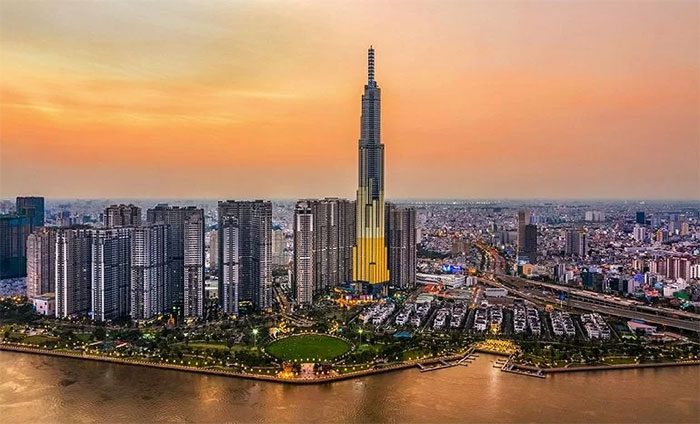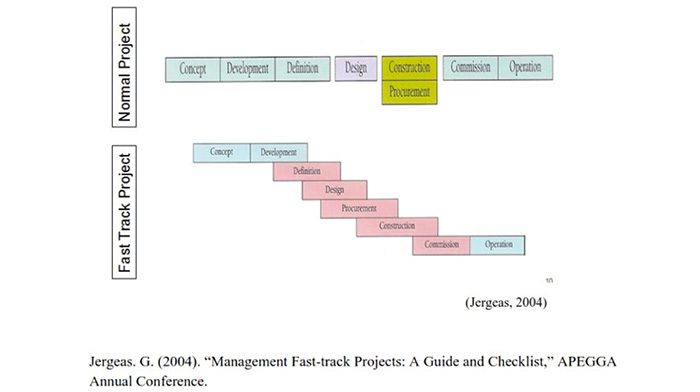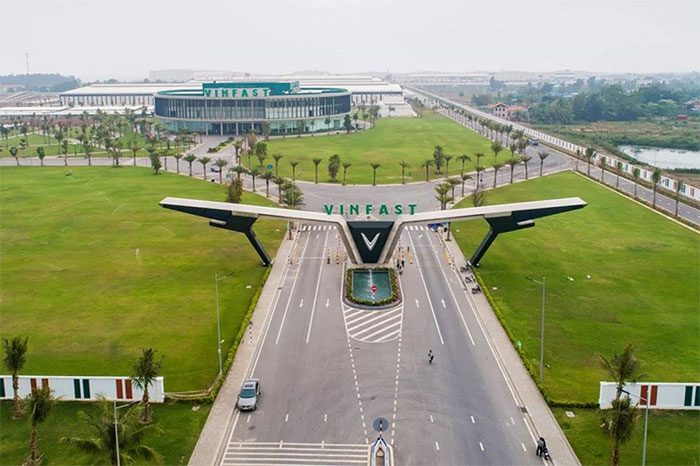In 2018, the completion of The Landmark 81, which was ranked among the top 10 tallest buildings in the world at that time, surprised many as it was built in just over a year. With a total floor area of up to 115,000m2, 90,000m2 of basement space, a foundation depth of 75m, and the use of more than 100,000m3 of concrete along with 80,000 tons of steel, this new symbol of Ho Chi Minh City became the fastest constructed skyscraper in the world, completing one floor in just 3.5 days.
Later, the VinFast factory in Hai Phong, covering over 500,000m2, was also completed in just 18 months. Rapid construction projects are increasingly emerging in Vietnam. Few people know that they all utilize a common model called “fast-track”.

The Landmark 81 building.
What is Fast Track?
The fast-track model is not new; it has been around since the 1930s. During a significant global economic crisis, the tallest building in the world at that time in the United States, the Empire State Building, was constructed in just 18 months using this method.
This is a project implementation method where the Investor (CĐT) aims to accelerate progress, shortening the time to bring the product to market, timely meeting customer demands or aligning with consumer trends at that moment.
Typically, traditional construction begins with concept design, sales research, followed by architectural design, construction, acceptance, and finally operation.
However, with the fast-track model, to save time and costs, design, construction, and acceptance are carried out simultaneously. This means that the project starts as soon as the Investor finalizes the design concept and sales strategy, allowing contractors to commence construction even while design drawings are not yet complete.

Comparison between traditional model and Fast-track model.
With fast-track, design and construction are coordinated to minimize the total construction time. For example, the Investor may allow the contractor to begin the foundation and build four floors before many details in the architectural, structural, and mechanical drawings are completed. Being able to contract without waiting for 100% design completion allows contractors to start construction 6 months to a year earlier.
Fast Track – A Threefold Benefit
The first benefit that fast-track brings is for customers, who can quickly own a building/project on schedule. For the Investor, fast-track helps shorten construction time and save costs such as land rental fees, personnel costs, and management expenses. When a project is completed early, the Investor can quickly generate revenue. For instance, in the case of The Landmark 81, reports indicate that the Investor began generating income just over a year after completion. The VinFast office building was constructed in just 5 months, while the entire manufacturing complex took 18 months, rather than the usual 2.5 to 3.5 years.
Even when the substantial revenue from a skyscraper is not a major concern, fast-track can also help the construction industry reduce costs caused by inflation. For example, if inflation is at 7-10% per year, shortening construction time by just 6 months can save 3.5-5%. Moreover, rapid construction also helps the Investor mitigate project management risks, as everything is condensed into a short timeframe instead of being spread out.

VinFast factory complex completed after 18 months.
From the contractor’s perspective, fast-track helps reduce the risk of bad debts and creates sustainable revenue. Typically, construction under the general contractor model requires performance guarantees, which account for about 8-10% of the total contract value. Contractors may struggle with this guarantee if the project has not been licensed. The risk is that if the project implementation time is prolonged, it will lead to delays and increased costs/material inflation, which will exceed the original contract price. All these additional costs will put pressure on the contractor.
With the fast-track model, payments between the Investor and contractor will be approved based on the actual construction volume on-site. The risk of missing work quantities or underestimating tasks is nearly nonexistent. Additionally, with the rapid project implementation, contractors mitigate the risks of cost increases due to inflation and rising material prices.
However, the biggest benefit that fast-track offers to contractors is likely the creation of sustainable revenue. Large-scale projects are often divided into many phases, such as the VinFast, Hoa Phat, and Lego factories. Contractors who perform well in the initial phases will continue to receive additional work from the Investor in subsequent phases. Furthermore, projects implemented under the fast-track model are typically carried out by large Investors with strong cash flow.
Why is this the case? Let’s do some math with The Landmark 81 project. With a total construction capital of approximately 300 million USD disbursed in just over a year, it means that, on average, the Investor had to spend about 20 million USD each month. In the VinFast factory project, just the revenue from Coteccons – the contractor involved in all three phases of the factory construction in Hai Phong – has reached over 10 trillion VND.
Therefore, for contractors, fast-track is the safest construction method in a challenging economic context, helping them reduce the risks of bad debts, quickly recover receivables, and generate sustainable revenue and profits.
However, fast-track is still not a perfect construction solution. The faster the construction, the more overlapping work there is. The greatest risk is the potential for design errors. Rather than saving the Investor millions of USD in costs, design-construction mistakes can inflate the construction budget compared to the initial estimate. Many completed sections may need to be demolished and rebuilt. Alternatively, the Investor may have to allocate a significant budget to pay for numerous materials that were ordered incorrectly because, during fast-track construction, drawings are frequently updated. Consequently, both the Investor and contractor are required to possess sufficient capability and experience, and fast-track is generally considered a specialty of larger contractors.


















































